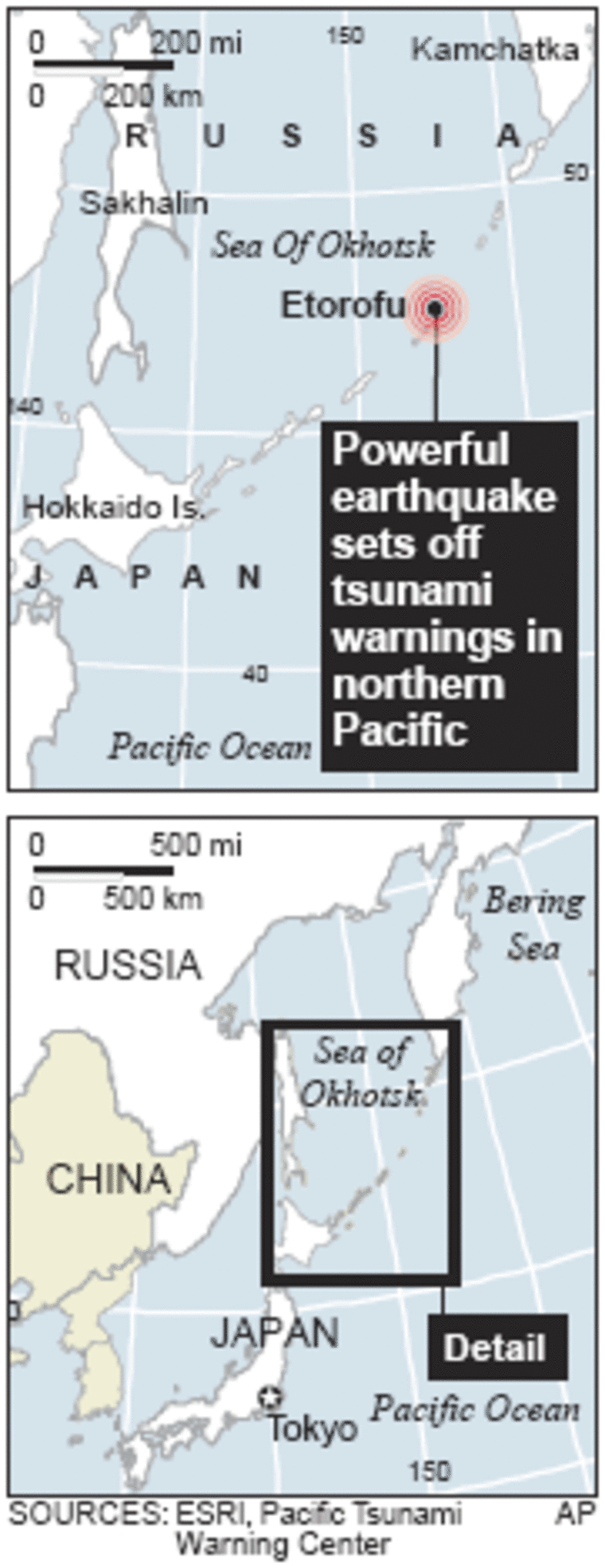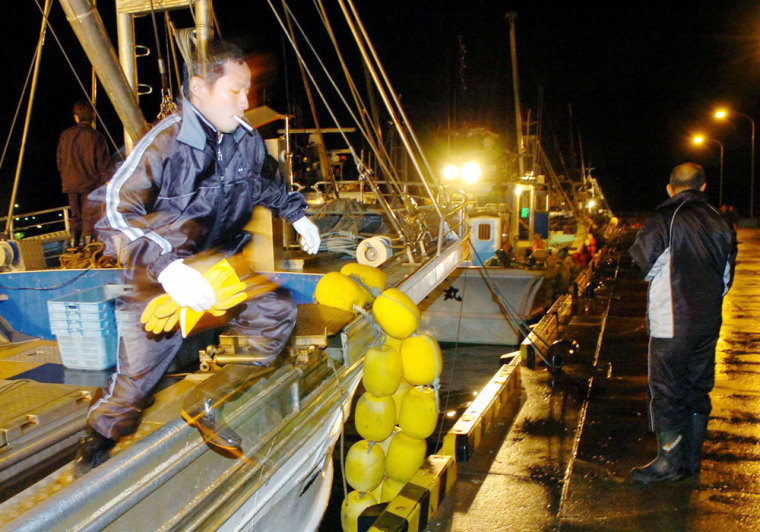Thousands of people living along northern Japan’s Pacific coast fled to higher ground Wednesday after a powerful undersea earthquake prompted tsunami warnings as far away as Alaska. Waves generated by the quake hit Hawaii hours later without causing problems, officials said.
The 8.1-magnitude quake struck an area claimed by both Russia and Japan, but the waves near Japan did not swell higher than 23 inches. There were no immediate reports of casualties or damage.
Six hours later, tsunami waves up to nearly 4-feet high caused by the quake crashed into Hawaii’s shores, civil defense officials said.
The Pacific Tsunami Warning Center had earlier canceled a tsunami watch. Center geophysicist Stuart Koyanagi said the alert was ended when it became clear the waves were unlikely to top about 3½ feet. “Usually things around a meter or less are not going to cause problems.”
Japan’s meteorological agency also withdrew its tsunami warning after about three hours. Tsunami warnings posted for Russia and coastal areas of Alaska also were canceled, as were tsunami watches for the Philippines, Taiwan, Indonesia and several Pacific islands.
In the Philippines, thousands of residents in northern coastal towns fled to safer ground because of rumors and miscommunication, officials said Thursday. People reported receiving cell phone text messages warning them to flee their homes because of a tsunami.
In Japan, communities along Hokkaido’s northeastern shore spent several tense hours bracing for larger waves, with thousands fleeing the coastline for higher ground. Fishermen scrambled to secure their boats, police cars made rounds of deserted piers, and ad hoc evacuation centers were set up in schools and town halls.
Masayuki Kikuchi, a town official in Nemuro, in Hokkaido, said the city dispatched about 20 fire trucks and cars immediately after the tsunami alert to instruct coastal residents to evacuate to higher ground.
“There was no panic,” Kikuchi said. “Residents made their way to high ground, just like they do in our annual tsunami drill.”
Residents in Japan, one of the world’s most quake-prone countries, learn through countless drills and government campaigns that temblors can generate waves that can rise to deadly heights once they arrive at shore.
In 1993, a quake off Hokkaido triggered a tsunami measuring 100 feet tall on Okushiri Island, flattening homes there within minutes. More than 200 people died in the waves, and in fires caused by the quake.
Japan’s Meteorological Agency issues tsunami warnings even when only tiny waves are expected, and the country’s most heavily populated coastlines are fitted with loudspeakers to order tsunami evacuations. Hirokawa, a coastal town in western Japan, holds annual shouting competitions for tsunami warnings.
Wednesday’s quake struck at 6:15 a.m. EST about 245 miles east of the island known in Japan as Etorofu, according to the Japanese meteorological agency. It put the magnitude at 8.1, while the U.S. Geological Survey estimated the magnitude at 7.8.
Etorofu, which is about 110 miles northeast of Hokkaido, is one of four islands in the southern Kuril chain claimed by both Japan and Russia. Etorofu is known in Russia as Iturup.
The Japanese meteorological agency initially warned of tsunami about 6½ feet tall or higher, and issued an alert for northeast Hokkaido. The first wave was recorded at Nemuro port on Hokkaido hit about 45 minutes after the quake struck, but was estimated at only 16 inches.
The waves got progressively smaller, though the agency said one measuring 23 inches hit Tokachi port in south Hokkaido almost four hours after the quake. All tsunami alerts and watches were called off at 11:30 a.m. EST.
In Hawaii, local civil defense authorities still warned people to stay out of the water and to exercise caution near harbors given the possibility the earthquake would generate unusual currents around the islands.
A woman swimming at Waikiki suffered cuts when she was sucked through an opening in a seawall as the water receded just before the swells arrived.
On the island of Kauai, a 2½-foot swell flooded a parking lot at Nawiliwili Harbor. It was one of a series of waves that struck between 12:30 p.m. through 2 p.m. EST, said Mark Marshall, Kauai County civil defense administrator.

He said there was no serious damage from the tsunami. No one was evacuated.
Marshall said Hawaii was lucky because it had six hours to prepare for the tsunami. Officials were able to observe how the waves affected Japan and Russia. They could also watch the waves move east across the Pacific by studying dart buoy measurements and data from Midway Island tidal gauges.
In Russia, no damage or casualties were reported as a result of the quake, according to Olga Shekhovtseva, spokeswoman for the Emergency Situations Ministry branch in the Sakhalin region, which includes the Kuril Islands.
Residents in the sparsely populated Kurils were warned of the threat but were not evacuated, she said, contradicting earlier Russian news agency reports that said residents were being evacuated from shoreline areas to safer ground.
The Russian-held islands, which Japan calls the Northern territories, were occupied by the Soviet Union in the closing days of World War II. They are surrounded by rich fishing waters and are believed to have promising offshore oil and natural gas reserves, and also have gold and silver deposits. The population, though, has plummeted to just 9,900, according to official statistics.
Temblors of magnitude 7 or higher are generally classified as major earthquakes, capable of widespread, heavy damage.
A magnitude 9.1-magnitude earthquake off the coast of Indonesia on Dec. 26, 2004 caused a tsunami that killed at least 213,000 people in 11 countries. Those waves reached as high as 33 feet.
